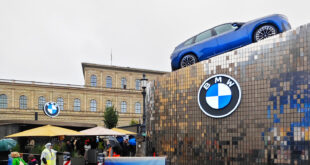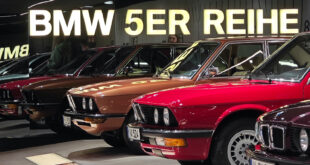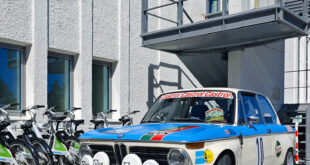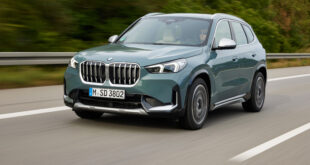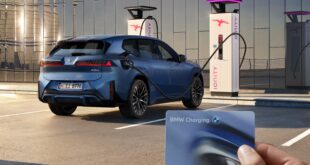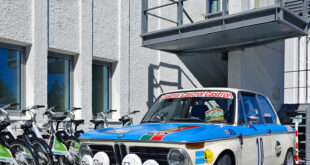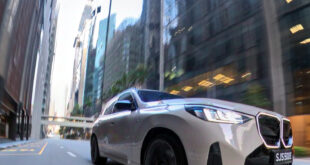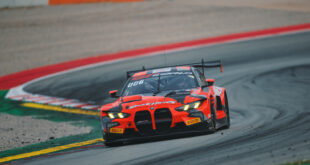If you’ve ever been to the BMW Museum, you’ll know there’s a special space on the top floor where BMW hosts rotating, carefully curated exhibits throughout the year. And if you haven’t, now you do. On all my previous visits, these changing displays were just a delightful bonus to the main attraction that is the museum itself. But this time, things were different. This time, the exhibit wasn’t just an afterthought; it was the reason I came. Everyone, welcome to Belle Macchine.

As a designer by profession, I’ve always been fascinated by the aesthetics of cars. Truth be told, how a car looks plays a huge part in my decision when choosing one of my own. After all, visuals are among the strongest emotional triggers for most of us. This new exhibit taps right into that, an exploration of the Italian influences that have shaped BMW’s approach to automotive design featuring a few of the marque’s rarest and least-seen creations.

Take this, for example, the 1970 BMW Garmisch, originally styled by Marcello Gandini for Bertone. The car you see here is actually a recreation, as the original was lost to time shortly after its debut at the 1970 Geneva Motor Show. Using extensive research, period photographs, and direct input from Gandini himself, BMW’s design team digitally rebuilt the Garmisch in 3D before it was painstakingly hand-crafted by artisans in Turin, just as it had been half a century ago.


Don’t you think the new Neue Klasse iX3’s lights and grille bear more than a passing resemblance to the Garmisch? The clean, geometric lines and upright proportions feel almost like a modern reinterpretation of Gandini’s design.

Not a BMW you come across very often, this is the 3200CS, another Bertone creation, but this time penned by none other than design legend Giorgetto Giugiaro. While it might look surprisingly modern, this elegant sportscar actually marked the end of BMW’s postwar luxury platform. Its beautiful lines, however, went on to inspire the 2000CS Neue Klasse. This particular cabriolet version was a one-off build, for their major shareholder, Herbert Quand.


Another interesting tidbit, the 3200CS was initially planned to feature a Pininfarina-crafted Lancia Flaminia Coupe body with a BMW front end. Thankfully, BMW’s management rejected that proposal and instead commissioned Bertone to design the car from the ground up, a decision that, in hindsight, couldn’t have turned out better.
Fun fact: the Coupe variant of the 3200CS was also the very first BMW to feature the iconic Hofmeister kink!



And of course, not too far away is the Neue Klasse sedan.



While it might look like a regular Neue Klasse at first glance, this is actually a one-off 1500 Coupe prototype, the predecessor to the 2000CS and later the E9, designed and built by Giovanni Michelotti. Its sleek lines and refined proportions hint at the elegance BMW could have brought to production, but with the company carefully managing its finances at the time, this stunning coupe never made it to the showroom floor. A rare glimpse at what might have been.

So much history here.


My 2002 actually rolled out of the factory in this very shade of Golf Yellow! Way too bright and chirpy for me. I really am very curious who was the very first owner of my car and how did he/she look like to spec out such a bold colour!





If you’re in any way remotely interested in automotive design, there was A LOT to take in.



BMW otakus would instantly recognize these as BMW-Glas cars, thanks to their delightfully un-BMW-like grilles. Originally a farm machinery maker based in Dingolfing, Glas first ventured into motor scooters before building automobiles, eventually catching BMW’s eye in the late ’60s. BMW re-released a handful of Glas models with almost everything unchanged, aside from a shiny new BMW badge, giving these quirky little cars a second lease on life while keeping their distinct character intact.



And then there was this, my jaw practically hit the floor the moment I saw it, and my heart immediately started racing. The Zagato Z4 Coupe. Absolutely gorgeous. I had seen countless photos of this car, and while it already looked stunning in pictures, in real life it was phenomenal, an absolute joy to behold.




I’ve always been a fan of Zagato’s cars. From the charming little Zagato Alfa Juniors to the Nissan Autech Stelvio, their creations have always stood out to me, full of character, brimming with distinctive styling, and packed with signature design details woven into every model. This Z4 Zagato was no different; at every angle, there were countless delightful touches just waiting to be discovered.

This was (yes, again) another one-off, first displayed at the 2012 Concorso d’Eleganza Villa d’Este. The original plan was for BMW to sell it in limited numbers, but as we all know, that never happened. Producing it would have required substantial modifications to their Regensburg assembly line, which was busy building the E89 at the time. BMW was also unconvinced it would sell at its high price point of $150,000, though personally, I think it absolutely would have.



Handcrafted from aluminum, the car featured Zagato’s signature double-bubble roof. It was more than just a stunning concept, BMW had conceived it from day one to be a road-legal machine and even carried out high-speed testing, making it much closer to a fully functional prototype than a static show car.

Later that year, BMW also unveiled a drop-top variant of the Zagato Z4, which also never made it to production. What a shame.

For Singaporean auto-otakus, this one is particularly intriguing: the BMW Nazca M12. Unveiled at the 1991 Geneva Motor Show, it didn’t just turn heads — it completely stole the spotlight. Many showgoers even felt it was the spiritual successor to the legendary M1, and with good reason: the M12’s designer, Fabrizio Giugiaro, was the son of Giorgetto Giugiaro, the mastermind behind the M1’s iconic wedge.

Crafted from carbon fiber, a very exotic material at the time, the M12 kept its weight down to just 1,100 kilograms. Power came from BMW’s silky-smooth M70 5.0 V12, borrowed from the 750i and 850i Coupé, mounted in the middle. It produced a healthy 300 horsepower, sent through a six-speed manual gearbox, allowing the car to reach a top speed of 297 km/h.


Here’s the interesting bit: while this car sadly never made it to production (why BMW keeps teasing us, I’ll never know) and remains a one-off, Italdesign, the coachbuilders behind this beauty, actually produced a version of the M12 for the Sultan of Brunei and his brother, Prince Jefri Bolkiah. Unlike the original show car, this “production” version was fitted with the S70B56 BMW V12, upgraded by Alpina to deliver even more horsepower. Chassis 003/ID was painted blue and was last seen locally (albeit some time ago) on our sunny shores. Now you know!





Thanks for reading!
 BMW.SG | BMW Singapore Owners Community The Ultimate BMW Community – Established Since 2001
BMW.SG | BMW Singapore Owners Community The Ultimate BMW Community – Established Since 2001

